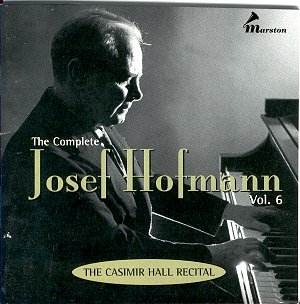The Fifth
volume in Marston’s Hofmann series took over the series from VAI
where it had languished awhile. Volume Six takes in more pianistic brilliance
from the Cadillac Hour broadcast of 1936 as well as the recital that
gives the slimline double its name, the Casimir Hall Recital of April
1938, which forms the bulk of the set. For good measure it adds – no
small addition – the Fourth Beethoven Concerto in the 1941 broadcast
conducted by John Barbirolli. The discs conclude with three different
performances of the first movement of the Moonlight Sonata –
two different takes from a Columbia session in 1916 and a Bell Telephone
Hour broadcast from 1944.
I reviewed
Volume Five recently and what strikes one so forcefully was the
sheer command of Hofmann, the depth of tone and the quasi-improvisatory
freedom he employed. This is quite apart from the beauty of his tone
and its immaculate production, its architectural strength. As one of
the elite pianists of the century these are some of the greatest survivals
in broadcast history, all the more so as the acoustic 1924 Brunswicks
were the last commercial discs he ever recorded despite numerous invitations
from a variety of recording companies. Some of the results of those
test records can be heard in Volume Five. Even so the variability of
some of the performances is curious and, as ever with Hofmann, fascinating.
His Beethoven was always controversial and has stimulated contentious
debate both pro and contra. Indeed Marston’s note includes an article
by Gregor Benko entitled Hofmann’s Beethoven and its Critics in
which two eminent critics, Bryce Morrison and Harris Goldsmith, are
soundly chastised for daring to decry Hofmann’s interpretations. So
it is with a certain degree of timidity that I say that it seems to
me that the big rubati and constant tempo fluctuations in the first
movement of the Moonlight – from the Cadillac Hour of 1936 -
will not be to all tastes, even to those mindful of historical performance
practice. The Allegretto is rather on the flippant side and the finale
is full of vigorous and massive attacks: altogether a highly idiosyncratic
and deeply personalised reading. It’s always interesting to hear Hofmann
play some modulating bars as he leaves one piece and before launching
into the next – a relic of previous performance history. I admired his
Chopin A flat Waltz from the same concert – full of elegance, elasticity
and superbly carved inner voicings; the D flat Waltz is correspondingly
dramatic and writ large.
The Casimir Hall Recital at the Curtis Institute of
which Hofmann was for many years Director is a fascinating document.
It opens here with the Waldstein Sonata, which again, like the
Moonlight, is a temperamental and wilful affair, full of tempo
fluctuations once more and some rhetorical flourishes. His Kreisleriana
is full of interest though; splendid accents and drama, for example,
in the second (he programmed only six). The first disc ends with more
Chopin – there is some shatter in the Polonaise in E flat minor but
not enough to distract from Hofmann’s strong attacks. In the Nocturne
in B some of his runs can sound rather decorative and unfeeling – it’s
also quite quick and cool – though his left hand touch is really truly
beautiful. The second disc picks up where the first ended with more
Chopin – an energetic and aggressive Valse Brillante, with rather metallic
attacks, maybe over emphasised by the recording. It continues with the
Nocturne in B – rather détaché phrasing to begin with
and a considerable amount of rubato before some venomous attacks and
incendiary bass notes incinerate the piece. The Chopin-Hofmann Minute
Waltz is vitiated rather by some acetate whine but features the quasi-improvisatory
quality so admired in Hofmann, whilst Stojowski’s Caprice Orientale
is certainly a passionate slice of exotica in these hands. When it comes
to the Schubert-Godowsky Moment Musicale Hofmann brings out left hand
melodies and highlights individual notes to characteristic effect.
The Fourth Beethoven Concerto receives some arresting
support in the shape of John Barbirolli here conducting an unnamed orchestra
(wasn’t it the New York Philharmonic?). Hoffman opens briskly, Barbirolli
offering a pliable orchestral patina strong on string moulding. Hofmann
reaches an apogee of delicacy in his right hand in the first movement
but the idiosyncratic cadenza, which rises to a peak of fury, is hardly
the last word in Beethovenian subtlety. By contrast his responses to
the orchestral statements in the second movement are very slow indeed
and some peculiarities or fruitful idiosyncrasies, take your pick accompany
his phrasing in the Rondo finale. The set concludes with the three Moonlight
Sonata first movements. There is a gross discrepancy between the
takes recorded for Columbia on 13th October 1916 – one lasting
5.04 and the other 4.12. The first sounds measured and correspondingly
quite impressive, the second sounds hurried with abrupt accents. The
third performance comes from a much later 1944 broadcast – and lasts
5.40 which is rather more in line with the complete performance recorded
in March 1936 for the Cadillac Hour, which began the set.
After the many highlights of Volume 5 I admit I found
this volume frustratingly uneven. Amidst the many splendours and tonal
beauties, the conjunction of superb right hand and active left, the
over-emphases and digital warmongering frequently verged on the uncontrolled.
And yet no one who professes to admire Hofmann could afford to be without
these discs that manage so well to preserve the musical testament of
so exciting, so unpredictable and so great a musician. Whatever demons
affected him in his later years no one could deny his place in the pantheon.
Jonathan Woolf

